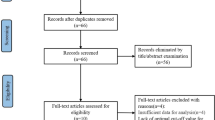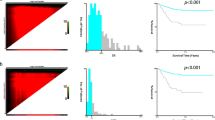Abstract
Background
This retrospective study investigated the prognostic value of serum inflammatory markers in nasopharyngeal carcinoma (NPC) patients, focusing on their association with overall survival (OS) and liver metastasis-free survival (LMFS).
Methods
The study included 314 NPC patients treated between 2010 and 2020. Clinical characteristics, treatment methods, and serum inflammatory markers were assessed. Patients were categorized into two groups of with and without liver metastasis. Univariate and multivariate Cox regression and Kaplan–Meier survival analyses were performed to investigate the prognostic value of serum inflammatory markers in NPC patients with and without liver metastasis.
Results
In the whole cohort, univariate Cox regression analysis singled out tumor necrosis factor-α (TNF-α) (HR = 1.57, 95% CI 1.44–4.90, p = 0.004) and neutrophil-to-lymphocyte ratio (NLR) (HR = 2.13, 95% CI 1.33–3.99, p = 0.009), which were significantly associated with poorer OS. In patients with liver metastasis, TNF-α and NLR could not independently predict OS. However, high TNF-α levels were independently associated with worse OS in patients without liver metastasis (HR (95% CI) = 2.75 (1.67–8.68), p < 0.001). High NLR levels could independently predict poor OS in both groups with (HR (95% CI) = 1.94 (1.77–6.38), p = 0.010) and without liver metastasis (HR (95% CI) = 1.58 (1.19–7.54), p = 0.009). Ultimately, TNF-α and NLR could not significantly predict LMFS.
Conclusion
This study highlights the prognostic significance of TNF-α and NLR in NPC patients, especially in those with liver metastasis. These inflammatory markers could serve as valuable indicators for assessing the prognosis of NPC patients. Further research is warranted to validate their clinical utility and explore potential therapeutic implications.


Similar content being viewed by others
Data availability
The data supporting the findings of this manuscript is available by the corresponding author and can be reached on request.
References
Chang ET et al (2021) The evolving epidemiology of nasopharyngeal carcinoma. Cancer Epidemiol Biomark Prev 30(6):1035–1047
Avdulla CS et al (2021) Epidemiological characteristics and survival analysis of patients with nasopharyngeal cancer in Western Greece. Cureus 13(4):e14711
Iqbal MS et al (2022) Survival outcomes for patients with nasopharyngeal carcinoma in non-endemic region in the UK treated with intensity modulated based radiotherapy 65 Gy in 30 fractions ± weekly cisplatin chemotherapy. Rep Pract Oncol Radiother 27(3):401–409
Kazemian A et al (2022) Long-term survival rates of patients with nasopharyngeal carcinoma treated by radiochemotherapy: a retrospective cohort study. Egypt J Otolaryngol 38(1):23
Su SF et al (2011) Treatment outcomes for different subgroups of nasopharyngeal carcinoma patients treated with intensity-modulated radiation therapy. Chin J Cancer 30(8):565–573
Niu X et al (2022) Long-term outcomes of nasopharyngeal carcinoma patients with T1–2 stage in intensity-modulated radiotherapy era. Int J Med Sci 19(2):267–273
Haleshappa RA et al (2017) Epidemiology and outcomes of nasopharyngeal carcinoma: experience from a regional cancer center in Southern India. South Asian J Cancer 6(3):122–124
Wei WI, Kwong DL (2010) Current management strategy of nasopharyngeal carcinoma. Clin Exp Otorhinolaryngol 3(1):1–12
Schmidt A, Weber OF (2006) In memoriam of Rudolf virchow: a historical retrospective including aspects of inflammation, infection and neoplasia. Contrib Microbiol 13:1–15
Li Q et al (2021) Prognostic value of inflammatory markers in nasopharyngeal carcinoma patients in the intensity-modulated radiotherapy era. Cancer Manag Res 13:6799–6810
Chao B et al (2020) A Novel Prognostic Marker Systemic Inflammation Response Index (SIRI) for Operable Cervical Cancer Patients. Front Oncol 10:766
Pacheco-Barcia V et al (2020) A systemic inflammation response index (SIRI) correlates with survival and predicts oncological outcome for mFOLFIRINOX therapy in metastatic pancreatic cancer. Pancreatology 20(2):254–264
Hu M et al (2020) Pretreatment systemic inflammation response index (SIRI) is an independent predictor of survival in unresectable stage III non-small cell lung cancer treated with chemoradiotherapy: a two-center retrospective study. Ann Transl Med 8(20):1310
Wang L et al (2020) Prognostic value of the systemic inflammation response index (SIRI) before and after surgery in operable breast cancer patients. Cancer Biomark 28(4):537–547
Zhao QT et al (2016) Prognostic role of platelet to lymphocyte ratio in non-small cell lung cancers: a meta-analysis including 3,720 patients. Int J Cancer 139(1):164–170
Liu H et al (2013) Pretreatment platelet-to-lymphocyte ratio (PLR) as a predictor of response to first-line platinum-based chemotherapy and prognosis for patients with non-small cell lung cancer. J Thorac Dis 5(6):783–789
Gunderson LL et al (2004) Impact of T and N Stage and Treatment on Survival and Relapse in Adjuvant Rectal Cancer. J Clin Oncol 22(10):1785–1796
Jen C-W et al (2020) Prognostic classification for patients with nasopharyngeal carcinoma based on American Joint Committee on cancer staging system T and N categories. Therap Radiol Oncol 4:2
Chiang CL et al (2021) Prognostic factors for overall survival in nasopharyngeal cancer and implication for TNM staging by UICC: a systematic review of the literature. Front Oncol 11:703995
Baud D et al (2020) Second-trimester miscarriage in a pregnant woman with SARS-CoV-2 infection. JAMA 323(21):2198–2200
Lin C et al (2019) Systemic immune-inflammation index as a prognostic marker in patients with newly diagnosed metastatic nasopharyngeal carcinoma: a propensity score-matched study. Transl Cancer Res 8(5):2089–2098
Wang L et al (2023) The prognostic predictive value of systemic immune index and systemic inflammatory response index in nasopharyngeal carcinoma: a systematic review and meta-analysis. Front Oncol 13:1006233
Zeng Z et al (2022) Prognostic significance of systemic immune-inflammation index in patients with nasopharyngeal carcinoma: a meta-analysis. Syst Rev 11(1):247
Hua X, Long ZQ, Wang SF, Xu F, Wang MD, Chen JY, Zhang YL, Ni WQ, Gao YS (2023) Prognostic significance of the novel nutrition-inflammation marker of lymphocyte-C-reactive protein ratio in patients with nasopharyngeal carcinoma receiving concurrent chemoradiotherapy. Front Nutr. 10:1162280. https://doi.org/10.3389/fnut.2023.1162280
Yang S et al (2019) Prognostic significance of hematological markers for patients with nasopharyngeal carcinoma: a meta-analysis. J Cancer 10(11):2568–2577
Kobayashi T et al (2010) Inflammation-based prognostic score and number of lymph node metastases are independent prognostic factors in esophageal squamous cell carcinoma. Dig Surg 27(3):232–237
Cupp MA et al (2020) Neutrophil to lymphocyte ratio and cancer prognosis: an umbrella review of systematic reviews and meta-analyses of observational studies. BMC Med 18(1):360
Howard R, Kanetsky PA, Egan KM (2019) Exploring the prognostic value of the neutrophil-to-lymphocyte ratio in cancer. Sci Rep 9(1):19673
AkinciOzyurek B et al (2017) Prognostic value of the neutrophil to lymphocyte ratio (NLR) in lung cancer cases. Asian Pac J Cancer Prev 18(5):1417–1421
Bartlett EK et al (2020) High neutrophil-to-lymphocyte ratio (NLR) is associated with treatment failure and death in patients who have melanoma treated with PD-1 inhibitor monotherapy. Cancer 126(1):76–85
Misiewicz A, Dymicka-Piekarska V (2023) Fashionable, but what is their real clinical usefulness? NLR, LMR, and PLR as a promising indicator in colorectal cancer prognosis: a systematic review. J Inflamm Res 16:69–81
Tominaga T et al (2023) Efficacy of neutrophil-to-lymphocyte ratio for cancer-specific survival in elderly patients with localized colon cancer: a single center propensity score-matched analysis. Clin Exp Gastroenterol 16:1–9
Shibutani M et al (2013) A High preoperative neutrophil–to–lymphocyte ratio is associated with poor survival in patients with colorectal cancer. Anticancer Res 33(8):3291–3294
Ouyang H et al (2023) Baseline and early changes in the neutrophil–lymphocyte ratio (NLR) predict survival outcomes in advanced colorectal cancer patients treated with immunotherapy. Int Immunopharmacol 123:110703
Pirozzolo G et al (2019) Neutrophil-to-lymphocyte ratio as prognostic marker in esophageal cancer: a systematic review and meta-analysis. J Thorac Dis 11(7):3136–3145
Shimada H et al (2010) High preoperative neutrophil-lymphocyte ratio predicts poor survival in patients with gastric cancer. Gastric Cancer 13(3):170–176
Yang P et al (2022) Neutrophil-to-lymphocyte ratio trend: A novel prognostic predictor in patients with nasopharyngeal carcinoma receiving radiotherapy. Int J Biol Markers 37(3):270–279
Liao LJ et al (2018) Prognostic impact of pre-treatment neutrophil-to-lymphocyte ratio (NLR) in nasopharyngeal carcinoma: A retrospective study of 180 Taiwanese patients. Clin Otolaryngol 43(2):463–469
Setakornnukul J et al (2021) Cutoff point of neutrophil-to-lymphocyte ratio for predicting survival in nasopharyngeal carcinoma. Medicine (Baltimore) 100(34):e27095
Yanni A et al (2022) Neutrophil-to-lymphocyte ratio as a prognostic marker for head and neck cancer with lung metastasis: a retrospective study. Eur Arch Otorhinolaryngol 279(8):4103–4111
Takenaka Y et al (2022) Neutrophil-to-lymphocyte ratio as a prognostic marker for head and neck squamous cell carcinoma treated with immune checkpoint inhibitors: Meta-analysis. Head Neck 44(5):1237–1245
Haddad CR et al (2015) Neutrophil-to-lymphocyte ratio in head and neck cancer. J Med Imaging Radiat Oncol 59(4):514–519
Ma SJ et al (2022) Evaluation of optimal threshold of neutrophil-lymphocyte ratio and its association with survival outcomes among patients with head and neck cancer. JAMA Netw Open 5(4):e227567–e227567
Yu Y et al (2018) Pretreatment neutrophil to lymphocyte ratio in determining the prognosis of head and neck cancer: a meta-analysis. BMC Cancer 18(1):383
Xu C, Yuan J, Du W, Wu J, Fang Q, Zhang X, Li H (2020) Significance of the Neutrophil-to-Lymphocyte Ratio in p16-Negative Squamous Cell Carcinoma of Unknown Primary in Head and Neck. Front Oncol. 10:39. https://doi.org/10.3389/fonc.2020.00039
Jang DI et al (2021) The role of tumor necrosis factor alpha (TNF-α) in autoimmune disease and current TNF-α inhibitors in therapeutics. Int J Mol Sci 22(5):2719
Wang X, Lin Y (2008) Tumor necrosis factor and cancer, buddies or foes? Acta Pharmacol Sin 29(11):1275–1288
Montfort A, Colacios C, Levade T, Andrieu-Abadie N, Meyer N, Ségui B (2019) The TNF Paradox in Cancer Progression and Immunotherapy. Front Immunol 10:1818. https://doi.org/10.3389/fimmu.2019.01818. Erratum in: Front Immunol. 2019;10:2515.
van Horssen R, Ten Hagen TL, Eggermont AM (2006) TNF-alpha in cancer treatment: molecular insights, antitumor effects, and clinical utility. Oncologist 11(4):397–408
Cruceriu D et al (2020) The dual role of tumor necrosis factor-alpha (TNF-α) in breast cancer: molecular insights and therapeutic approaches. Cell Oncol 43(1):1–18
Josephs SF et al (2018) Unleashing endogenous TNF-alpha as a cancer immunotherapeutic. J Transl Med 16(1):242
Mahdavi Sharif P et al (2020) Importance of TNF-alpha and its alterations in the development of cancers. Cytokine 130:155066
Yu Y et al (2019) Elevated levels of TNF-α and decreased levels of CD68-positive macrophages in primary tumor tissues are unfavorable for the survival of patients with nasopharyngeal carcinoma. Technol Cancer Res Treat 18:1533033819874807
Xie L et al (2013) TNF-α-308G/A polymorphisms and nasopharyngeal cancer risk: a meta-analysis. Eur Arch Otorhinolaryngol 270(5):1667–1672
Funding
None.
Author information
Authors and Affiliations
Contributions
All authors contributed to the study conception and design. Material preparation, data collection and analysis were performed by HS, YZ, GG and AR. The first draft of the manuscript was written by HS, FQ and DD. The project administration and final edit was conducted by QY. All authors commented on previous versions of the manuscript. All authors read and approved the final manuscript.
Corresponding author
Ethics declarations
Conflict of interest
No conflicts of interest to disclose.
Ethics approval
The protocol of the present study was approved by the Ethics Committee of the Hospital of Nanchang University.
Patient consent
Informed written consent was obtained from the patients to participate in the study. Besides, patients signed informed consent regarding publishing their data and photographs.
Additional information
Publisher's Note
Springer Nature remains neutral with regard to jurisdictional claims in published maps and institutional affiliations.
Rights and permissions
Springer Nature or its licensor (e.g. a society or other partner) holds exclusive rights to this article under a publishing agreement with the author(s) or other rightsholder(s); author self-archiving of the accepted manuscript version of this article is solely governed by the terms of such publishing agreement and applicable law.
About this article
Cite this article
Saboorifar, H., Zafarani, Y., Gholampour, G. et al. Serum inflammatory markers as prognostic marker for nasopharyngeal carcinoma with liver metastasis: a multi-center retrospective study. Eur Arch Otorhinolaryngol (2024). https://doi.org/10.1007/s00405-024-08649-2
Received:
Accepted:
Published:
DOI: https://doi.org/10.1007/s00405-024-08649-2




